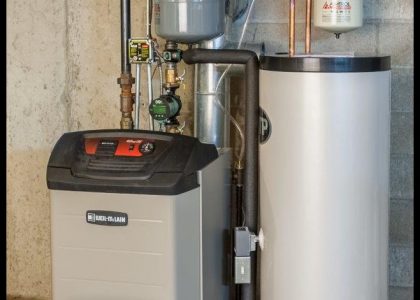If you have read our other blogs you will note that we are advocates of using a HEAT LOSS CALCULATOR to determine your heating system boiler size and radiation requirements. However, when replacing an existing boiler in a hydronic (forced hot water) system a shortcut method is available, subject to some qualifications.
Measuring your total radiation (baseboard registers, radiators, cabinet convectors, unit heaters, radiant, etc.) can provide a good estimate of boiler size requirement. Simply put, installing a boiler that is larger than your radiation capacity is foolhardy. Excessive energy delivery cannot be utilized.
Common residential baseboard is typically rated at between 550 to 700 BTU’s per linear foot, and typically at a water delivery temperature of 180°F by the manufacturer(s). These values vary with the construction, by manufacturer and somewhat by register height. A “rough measure”:
- 7-1/2” or under height (typically) = 600+/- BTU/Ft. (Variation +/- 50BTU)
- Taller than 7-1/2” is likely 700+/- BTU/Ft.(Variation +50BTU)
- Cast Iron Residential Baseboard is usually around 600BTU/Ft.
Notes:
1. There is no substitute for identifying your specific manufacturer’s product and specification, if possible.
2. The “dirty little secret” however is that most of the baseboard radiation produced (particularly in New England) is by one regional supplier, and branded for boiler manufacturers to their specification. Thus the subtle aesthetic variations in sheet metal profiles.
Given the prior, merely measuring the nominal length of your “fin tube”, adding them up to obtain a total radiation length and multiplying by your estimated BTU/Ft. selection gives you a total radiation BTU capacity, and hence your boiler output requirement.
This covers the prevalent usage of baseboard radiation as a FHW heat transfer medium, but what about the others? They must be addressed separately as follows:
- Cabinet Convectors: These are usually readily identifiable and many have their output specifications on a product label (external or internal).
- Unit Heaters: Typically found in basements, garage or work areas for incremental use. They have an external chassis specification label with rated values.
- Radiators (typically converted from prior steam usage, but not always): The number of original suppliers and variations of these is daunting. There are online resources citing dated cataloging that are useful, but you have to dig!
- Radiant Radiation (In or under-floor tubing) calculation is more challenging. You must know the actual length and size of tubing utilized by whatever means or design records available.
There are other considerations to both qualify and quantify once you have your total BTU requirement calculation.
- When replacing a dated boiler (in a dated system) you must consider and qualify what has been done to the heated structure in the interim. Particularly any energy requirement changes effected by millwork (doors & windows) and insulation improvements must be considered.
- Have energy improvements changed the heating “proportions” of radiation requirements, exhibited by uneven room heating? If so, add radiation to extremely affected areas where overall balance cannot be achieved by modestly adjusting dampers on all other radiation. Remember, closing dampers will reduce heating efficiency.
- There is a benefit to be gained by having excessive radiation effected by energy improvements. Specifically, lower system operating temperatures and rapid recovery will facilitate thermostatically controlled, energy-saving setbacks.
- Similarly, the equipment duty cycle and mean boiler temperature reductions add up to measurable operating cost improvements.
Regarding Items 3 & 4, we offer two “new system” observations:
- Some new homes are designed so radiation-marginal that functional thermostat setbacks are minimal, if at all achievable under deep cold conditions.
- Full house “under-floor” and “in-concrete” tubing radiation systems offer virtually no effective temperature set-back capabilities, a notable energy penalty!
Summarizing, weigh the operating characteristics of your particular hydronic system application before selecting any boiler. Over-sizing beyond your radiation capacity is a waste of money. Given that:
- There is still no substitute for a well executed Heat Loss Calculation.
- Always upgrade your circulators, in particular a Taco 007e for the common Taco 007. Costs more, but pays back in less than two years in energy and potential maintenance costs.
- Also look at an intelligent FHW distribution option using a Taco Delta-T Circulator. An improvement to any system that returns great benefits! (Read our other Blogs.)
As another resource, Weil-McLain has a new Boiler Replacement Guide that we highly recommend.
“Times are a-changing” as they say, and quickly. Don’t miss the bus!
Updated 01/25/2023 P.D.M. Sr.

